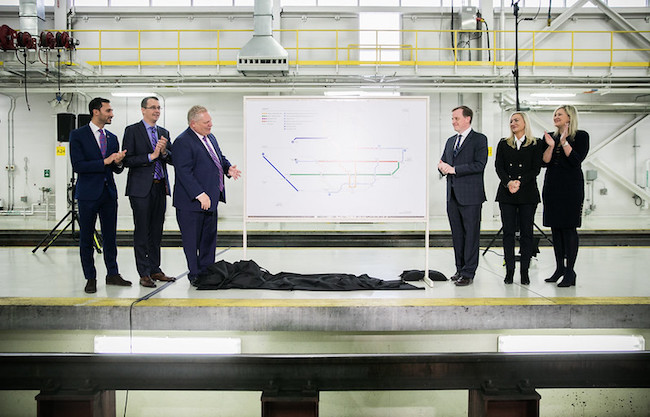
Construction capacity among major concerns for Ontario as it plans four-line $28.5B transit expansion
By David Kennedy
InfrastructureThe huge new transit program will be competing for labour with health care initiatives, nuclear refurbishments and the seemingly endless list of private developments cropping up across the city

The province announced a major shift in its transit priorities earlier this year. Planners are now exploring how to get four new transit lines built. PHOTO: Province of Ontario
TORONTO—An overheated construction industry is among the big obstacles challenging planners responsible for delivering a four-line transit expansion program in Toronto over the next 10 years.
Provincial agencies Infrastructure Ontario and Metrolinx have been laying the groundwork for construction of the new Ontario Line and extensions to three other transit lines this fall. The heads of both agencies addressed questions on how they plan to tackle the complex series of projects, worth an estimated $28.5 billion, at the annual conference of the Canadian Council for Public-Private Partnerships in Toronto Nov. 19.
Ehren Cory, president and CEO of Infrastructure Ontario, said his team is tracking the construction industry’s capacity to take on the billions of dollars in new work, in what’s already an extremely busy market, closely. While the government plans to stage construction and to keep the industry apprised of what will be required when, significant concerns remain.
“When we look down the pipe, where it becomes more problematic is where you layer on not just our program, which is big in and of itself,” Cory said. “There are some significant health care-related projects also coming in the same time frame. Then there’s nuclear refurbishments going on in our market. And then there’s the private sector activity, which you only have to look around Toronto to see.”
Cory noted the agency’s “laying out the runway” for the four transit lines — the Ontario Line, the Yonge North subway extension, the Eglinton Crosstown West extension and the three-stop Scarborough subway extension — will help the industry prepare. Despite this staging, he said a recent study showed the projects running up against capacity issues in the early 2020s.
Currently, all four of the lines are scheduled to be delivered between 2027 and 2031. Along with competing for labour with a wide range of public and private building projects, the timelines coincide with a worsening worker shortage in the skilled trades and wider construction sector.
With Toronto and its suburbs continuing to swell, however, the two government agencies are pushing ahead on the major transit expansion in spite of the hurdles.
“When you’re behind for many decades in transit infrastructure, you very often have radial-type systems and the need that we have here in Ontario and in Toronto specifically with our subway program is to create more interconnectivity and more options for transfers,” Phil Verster, president and CEO of Metrolinx, said.
There will be no shortage of work.
“We are ploughing $4 billion worth of infrastructure into the region every year,” Verster said “I need to push that up to six or eight billion in the years to come.”
Infrastructure Ontario and Metrolinx have scheduled a number of “market soundings” in the final six weeks of 2019 to gather input from construction stakeholders on how best to proceed with the handful of multibillion-dollar projects.
Though the bulk of the construction on all four of the projects is still several years away, Infrastructure Ontario aims to get a program of early work into the market next year. Cory noted getting some of the “big chunks” of early work underway soon as possible will help accelerate and de-risk the main projects. He pointed to grade separations, crossings and even tunnelling as jobs that could have shovels in the ground shortly.




